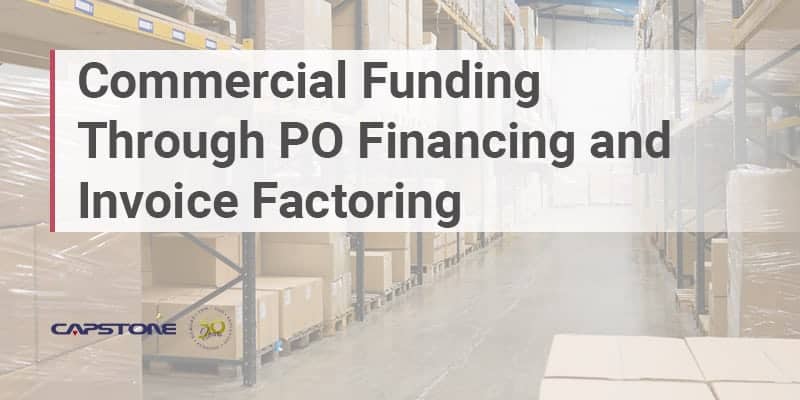Small and medium-sized businesses will often face cash flow and working capital problems at one point or another. For financial brokers or ISOs looking to help clients manage these issues, there is no one size fits all approach. The right type of business funding will depend on several factors, such as why the funding is needed, how quickly it is needed, and the business’s qualifications.
While business funding can come from various sources, traditional borrowing may not always be the best option to pursue. Banks and other institutional lenders tighten loan requirements and reduce credit exposure to these businesses when their help is needed most. Two alternative business funding options to consider for your clients are purchase order (PO) financing and accounts receivable factoring (aka “invoice factoring.”)
What PO Financing and Invoice Factoring Are Used For
PO financing and accounts receivable factoring are two financial strategies that your clients can use to purchase inventory or materials and accelerate the conversion of accounts receivable into cash. PO financing and invoice factoring are both used to address cash flow issues and provide working capital, but they are utilized at different stages in a transaction cycle.
PO financing is used to purchase inventory or other resources related to specific purchase orders or contracts. It provides funding to a business’s vendors or suppliers so they may fulfill an order or get started/complete a project.
Frequently, small and medium-sized businesses are unable to obtain credit from suppliers or a loan from a bank to purchase inventory or materials due to varying circumstances. It is important to note that in certain instances where the supplier is located outside the U.S., a letter of credit is usually required. PO financing provides businesses with the ability to fulfill orders as well as perform work BEFORE they’ve invoiced and received payment for the invoices. In effect, it’s an advance against the funds a business expects to receive once their customer’s invoice is paid and is intended to cover the cost of goods sold.
Invoice factoring, on the other hand, is a financial tool that businesses use to accelerate cash flow by selling their unpaid invoices for a completed order or project to a factoring company at a discount. Businesses receive cash immediately for unpaid invoices instead of waiting for their customers to pay. This funding can then be used for things such as payroll, operating expenses, growing the business, or the next contract or project.
Invoice factoring can be used by itself to accelerate cash flow without also using PO financing. However, when PO financing is used, invoice factoring is also typically used to complete the financing transaction.
While PO financing and invoice factoring are both designed to provide solutions to a business’s working capital and cash flow needs, the key points to consider are the timing of when the funds are needed in the transaction cycle and the use of funds.
Advantages of PO Financing
PO financing allows business owners to increase the working capital necessary to boost sales, increase product or service offerings, and allows the business to gain the edge over the completion.
PO financing is more accessible than a bank loan and may be easier to qualify for. The credit underwriting decision is based on the financial strength of the client’s customer, unlike a bank that uses the business’s credit profile regardless of the income and cash flow that will result from fulfilling a firm purchase order or contract.
Banks favor large customers and tend to reduce credit exposure to small and medium-sized businesses when they need it the most.
PO financing may sometimes cover up to 100% of the supplies, inventory, or resources needed to get started/complete a project or order without using credit available under existing lines of credit. It also enables clients to pursue business opportunities, which they might not otherwise be able to do because of insufficient working capital, and it can be a stepping stone to developing a relationship with a supplier that leads to open-account terms.
Advantages of Invoice Factoring
Invoice factoring helps to accelerate cash flow by converting accounts receivable to immediate cash. Clients will not have to wait 60+ days for their customers to pay an invoice. Having access to those funds increases cash flow and reduces the need to draw on availability under existing lines of credit.
An invoice factoring facility is also easier to obtain than a bank loan, and the credit decision is based on the financial strength of the client’s customer, not the client. Invoice factoring facilities are more flexible to use than bank loans and can be provided for a single invoice or as a program for all of a client’s accounts receivable. In addition, they can be custom tailored to fit a client’s business model.
Partner with Capstone for Fast Business Funding
Capstone is a leading commercial funding company that is focused on providing working capital to cash-starved businesses. Capstone can tailor a program using existing accounts receivable to generate working capital and cash flow that fits your clients’ business needs.
We offer every client:
- Fast funding and approval time
- Higher approval rates – unlike traditional lending institutions that scrutinize credit history and years in operations, Capstone is focused on the creditworthiness of the client’s customers
- Solutions for small to medium-sized businesses
- Competitive rates
- No maximum transaction sizes
- No long-term contracts
- Local and personalized service – all over the U.S., no matter where your client is located
If you would like to discuss PO financing and invoice factoring for your client’s business, please contact us at your earliest convenience.






